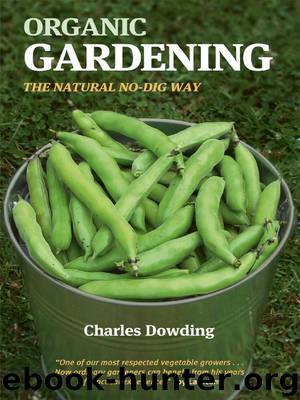Organic Gardening by Charles Dowding

Author:Charles Dowding
Format: mobi, epub
Publisher: Green Books (Perseus)
Published: 2015-07-08T08:08:09.236000+00:00
CELERIAC
Season of harvest: October to November, store until April Follow with: spring sowings or plantings
Turnip-rooted celery is a strong-tasting root, bringing the flavour of earth and celery to soups, stews and salads in winter and early spring. Celeriac loves to grow in well-composted soil offering moist conditions, and benefits from some extra watering in a dry summer. Its roots are fibrous and mostly superficial, which limits its growth in drier soils; a heavy clay is best.
I have grown many varieties and noticed few significant differences.
Sowing and planting
Decent-sized roots require a long growing season, so seed is usually sown under cover between late March and early May, for planting out by mid-June. The seeds are tiny and should not be covered with any compost, so a sheet of glass over the seed tray or modules is beneficial. Nothing will appear for up to three weeks, maybe when you are just about to give up!
The tiny seedlings should be pricked out into 3-4cm (2-2.5")modules, until about 7-8cm (3") high, then hardened off and planted after any risk of late frost, which would weaken but probably not kill them, and might encourage them to bolt before winter.
Growing
Regular hoeing or hand-weeding will probably be necessary until about August. By then, especially if you have planted ‘on the square’ at about 35x35cm (14x14"), there should be leaves covering all bare soil and preventing much new weed growth.
A thick surface dressing of compost always benefits celeriac immensely, both for a gentle supply of nutrients over its long season, and for retention of moisture in dry weather. Roots grow larger in wet summers.
By September there should be a fair-sized root, mostly above soil level. Some gardeners like to remove all lower leaves, supposedly to help roots to swell. I find this of little benefit growth-wise, but it makes the plants very attractive! I did a trial of one row de-leafed at the bottom, one row untouched, and the latter grew noticeably bigger.
Harvesting and storing
Lifting in November, and before any severe frost, is about right. Masses of fleshy roots make a spade or trowel helpful, together with a knife to sever roots as or after the plant is eased upwards. With the celeriac in hand, trimming of leaves and excess soil should reveal some hints of white flesh, but trim sparingly if you are harvesting to store the roots, in similar conditions to carrots – say in a box or sack in shed or garage, free of significant frost, because a thin layer of soil always helps to keep roots moist and firm.
Problems
Carrot root fly When preparing celeriac to eat, you may see lines of brown across and into its bottom end. These are tunnels of carrot root fly maggots, but as with parsnips the large bulk of the roots means that damage is less important.
Frost is a hazard because so much of the root is above ground and exposed to cold air.
Holes inside the roots can be from dry spells or varietal traits. Slug holes are more significant, often inhabited by woodlice, and many slugs may make an earlier harvest worthwhile.
Download
This site does not store any files on its server. We only index and link to content provided by other sites. Please contact the content providers to delete copyright contents if any and email us, we'll remove relevant links or contents immediately.
| Container Gardening | Hydroponics |
| Organic | Propagation & Cultivation |
| Topiary | Urban |
| Water Gardens & Ponds |
Turbulence by E. J. Noyes(7061)
The Thirst by Nesbo Jo(5802)
Gerald's Game by Stephen King(3930)
Be in a Treehouse by Pete Nelson(3238)
Marijuana Grower's Handbook by Ed Rosenthal(3132)
The Sprouting Book by Ann Wigmore(3060)
The Red Files by Lee Winter(2925)
The Remains of the Day by Kazuo Ishiguro(2629)
Sharp Objects: A Novel by Gillian Flynn(2457)
Christian (The Protectors Book 1) by L. Ann Marie(2397)
Organic Mushroom Farming and Mycoremediation by Tradd Cotter(2316)
The Culinary Herbal by Susan Belsinger(2066)
Stone Building by Kevin Gardner(2000)
The Starter Garden Handbook by Alice Mary Alvrez(1931)
Lilac Girls by Martha Hall Kelly(1885)
The Unlikely Pilgrimage of Harold Fry by Rachel Joyce(1841)
The Lean Farm Guide to Growing Vegetables: More In-Depth Lean Techniques for Efficient Organic Production by Ben Hartman(1792)
Urban Farming by Thomas Fox(1756)
Backyard Woodland by Josh VanBrakle(1593)
